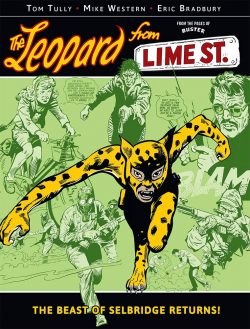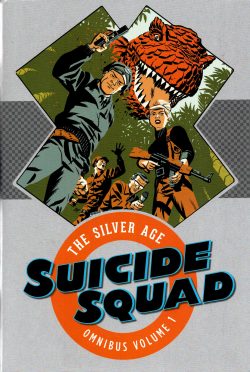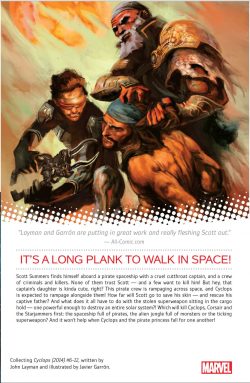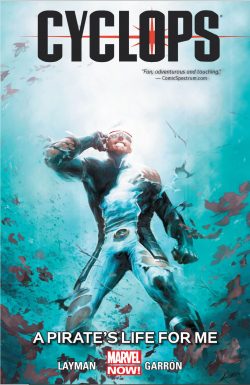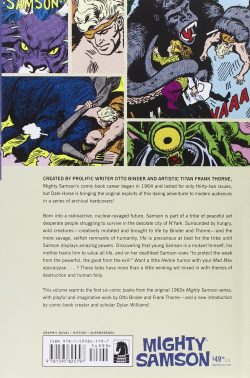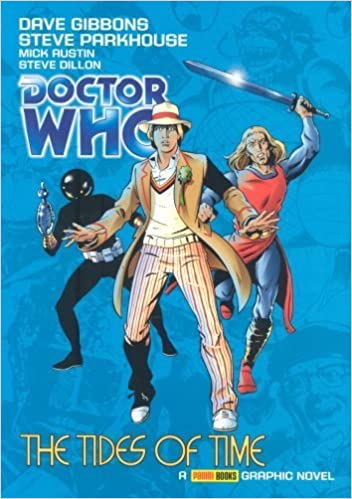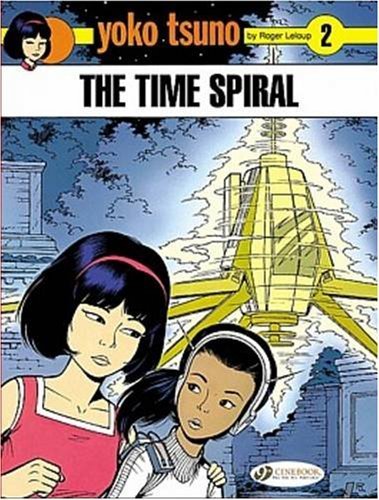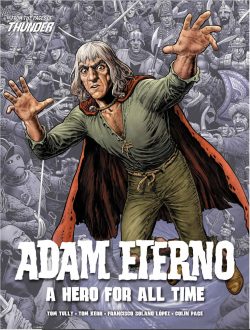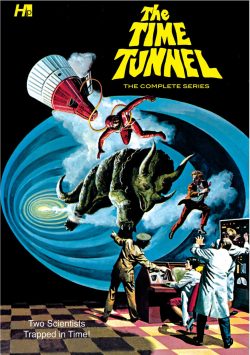
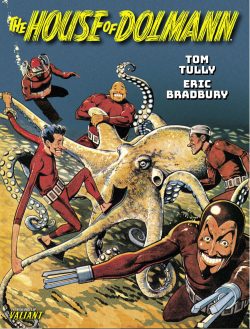
By Tom Tully & Eric Bradbury, with Carlos Cruz & various (Rebellion)
ISBN: 978-1-78618-491-7 (TPB/Digital edition)
Win’s Christmas Gift Recommendation: Weird, Wonderful, So Why Not?… 9/10
Wrapping up a week of Unamerican Superheroes is a classic British confection which might well be the closest we ever got to a Silver Age super-team – even if the members are technically all the same bloke…
Valiant debuted as a “Boys’ Paper” in 1962, as our indigenous periodicals industry struggled to cope with spiralling costs and a sudden mass importation of brash, flashy, full-colour comics from America. A weekly anthology dedicated to adventure features and providing a constantly-changing arena of action, the comic became the company’s most successful title for over a decade: absorbing many less successful titles whilst preserving their top features between its launch on October 6th and eventual amalgamation into new-styled, immensely popular Battle Picture Weekly in 1976. It also generated dozens of extra-sized Summer Specials and 21 Annuals between 1964 and 1985: combining original strips with prose stories; sports, science and general interest features, short humour strips and – increasingly from the 1970s onwards – reformatted reprints from IPC/Fleetway’s copious back catalogue.
In February of 1963 it merged with the company’s previous star vehicle Knockout and, mere months later, became the brand title for a series of fortnightly – later monthly – digest-sized comics volumes. The Valiant Picture Library offered longer stories at the cost of 1 shilling. It ran to 144 issues ending in 1969…
In May 1965, the weekly Valiant increased its price from sixpence to 7d (that was in old money, of course) but also increased the page count from 28 to 40 action and fun-packed pages, and ramped up the innovative anthological entertainment…
British weekly comics in the 1960s and early 1970s were a phantasmagorical playground of bizarre wonders. Truly recognisable heroes appeared in war, western and its gradually declining straight crime serials, whilst the most memorable momentum devolved to a hybrid, bastardized mixture of fantasy, horror and science fiction themes to spawn an evil-crushing pantheon unlike any other…
The Spider, Steel Claw, Thunderbolt, Phantom Viking, Captain Hurricane, Robot Archie, Kelly’s Eye, Cursitor Doom and others utterly tainted the gleaming pristine gene pool of noble superheroism with its bleak and often manic sensibilities. You can thank this stuff for the 1980s “British Invasion” of American comic books and the dystopian weltschmerz that dominated the industry for a decade thereafter, peppering the genre with our sort of misfit, maverick and malcontent misanthrope…
Even early on when we briefly adopted full-blown US style superheroes like Marvelman, Captain Universe, Danger Man and Thunderbolt Jaxon, or late entries Tri-Man, The Leopard from Lime Street, Gadget Man & Gimmick Kid and the wondrous Johnny Future at the height of “Batmania”, Brits could never really take it straight. There was always something daft, anarchic, quirky or just scarily warped in the final result…
Here’s a sublimely perfect example of all that: a seedy solitary inventor with a hidden past who spends his days playing with puppets: an obsessive who can’t help literally putting words into their mouths…
Another stunning salvo of baby boomer nostalgia courtesy of Rebellion’s Treasury of British Comics strand, this first collection of The House of Dolmann gathers the early material from Valiant, spanning October 8th 1966 (issue #208) to May 6th 1967, plus a late entry from Valiant Super Special 1980. The strip itself ran until May 1970, and has resurfaced a few times since then, both in reprint form and new tales…
It also offers an incisive Introduction from modern day comics scribe Simon Furman and begins with a handy character guide in ‘Meet Dolmann’s Dolls (part 1)’ providing a pictorial and text run-down of Astro, Elasto, Giggler, Micro, Mole, Raider and Togo: purpose-built robots designed with amazing specialised abilities. I’m sure I don’t need to remind you that this was the mid-Sixties, so racial depictions like the half-sized sumo wrestler-bot last cited were perpetrated “in fun”, and not fairness or good taste…
House of Dolmann was a curious, inexplicably compelling blend of super-spy and crime-buster strip scripted by the magnificently prolific Glasgow-born Tom Tully. His astoundingly broad output included classic delights like Roy of the Rovers, Heros the Spartan, Dan Dare, Master of the Marsh, Janus Stark, Mytek the Mighty, The Wild Wonders, Nipper, Adam Eterno, The Mind of Wolfie Smith, Johnny Red, Harlem Heroes, Mean Arena, Inferno, The Robo Machines, Football Family Robinson, Buster’s Ghost as well as many of the strips cited above.
His collaborative co-creator here also worked on many of those sagas. The incredibly gripping moody comic art of Eric Bradbury had begun gracing newsagents shelves in 1949 in Knockout. Frequently working with studio mate Mike Western, Bradbury drew strips like Our Ernie, Blossom, Lucky Logan, Buffalo Bill, No Hiding Place, The Black Crow and Biggles. He was an “in-demand” illustrator who worked into the 1990s on landmark strips like The Avenger, Phantom Force 5, Maxwell Hawke, Death Squad, Doomlord, Darkie’s Mob, Hook Jaw, The Sarge, Invasion, Invasion 1984, Rogue Trooper, Future Shocks, Tharg the Mighty and so much more…
From the start, Tully & Bradbury delivered intense, claustrophobic tension-drenched, action-packed episodic adventures, opening with a spectacular kidnapping at the London Opera House.
When Professor Hanson – head of Britain’s atomic missile program – is abducted by jetpack-wearing masked thugs, the police and security services are stumped and the authorities have no recourse but to call in independent contractors International Security. Enigmatic chief Mr. Marshal and his top aide promptly pop over to the East End and The House of Dolmann: a pokey shop owned by a grimy, creepy puppet seller who apparently makes ends meet as a mannequin repairman who also dabbles in second-hand dolls, puppets, animatronics and shop or museum dummies.
However, in the grotty emporium – looking like a blend of junk shop and the parlour set of Steptoe & Son – a brilliant inventor has been clandestinely building an army of automated assistants – if not actual friends – to do his bidding. The IS operatives are greeted by a 3-foot tall articulated sumo automaton who invites them inside. They are as yet unaware that the voice – and appallingly racist accent – in fact belongs to proprietor Eric Dolmann who uncontrollably puts words in the mouths of all his creations… and perhaps divides a series of multiple personalities amongst them all at the same time. Shabby Dolmann’s life is pure subterfuge. (I digress here, but an awful lot of “our” heroes were tattily unkempt: we had “Grunge” down pat decades before the Americans made a profit out of it!)
The bizarre figure is in fact a troubled engineering genius who designs and constructs an army of specialised robots disguised as puppets to act as his shock-troops in his a dark and crazy war against the forces of evil. They are all directly radio-controlled by the inventor, but seem to act with increasing autonomy as the months go by …
Top of his hit list is subversive organisation D.A.R.T. – the Department for Arson, Revolution and Terror – and he eagerly accepts the job of foiling their plans by single-handedly raiding their London secret HQ with small army of super-bots…
The assault is a complete success but in the resultant rout and rescue, D.A.R.T. boss Rafe Garrott gets away from Dolman and his “children”…
Pattern set, what follows is a potent and spectacular parade of peril-packed romps: complete 4-page thrillers alternating with extended sagas wherein the troubled and frankly disturbing puppeteer and an ever-expanding team tackle high-tech kidnappers, rascally protection racketeers, road haulage hijackers, weapons dealers, bullion bandits, museum marauders, blackmailers and a silver-obsessed madman…
In his unceasing war on wickedness, the daring Dolls hunt and confront modern-day river pirates, escaped killer convicts, train robbers and mail van raiders, fur-thieves, mad scientists Dr. Magno and Doctor Volt, a costumed cat-burglar, super-sophisticated safecrackers, deranged arsonist Firebug, cunning counterfeiters in their tricked-out funfair of doom, a brutal biker gang and – repeatedly – the massed minions of arch super-criminal ‘The Hawk’. The half-pint heroes even infiltrate a prison in search of justice…
As the series progressed, additions were made to the synthetic squad – like tactical calculator Egghead – and supplemental gadgets such as a flying Dolmobile and all-terrain Dol-Bike (with sidecar for the fractious, ever-squabbling toy boys), tacitly acknowledging the tropes and trends gripping the world beyond the comic.
A slow backstory develops, hinting at the inventor’s murky past. Eventually his real name – Jonas Luthor – is revealed after his obscuring clown mask falls off in a tussle with a career criminal. The accident belatedly leads to his squalid shop being threatened by a police raid as diabolical plunderer The Gold Miser drives London into a glistering plutocratic panic and it takes all Dolmann’s ingenuity and dexterity to deflect, divert, disinform and save the day…
Ultimately, wild sci fi spy paraphernalia like levitation ray thieves and the tank-driving Commando Raiders inform and dominate the stories, with D.A.R.T.’s resurrection adding layers of fearsome fantasy frenzy. Crucially, the always-unsettling sight of dolls perpetually arguing amongst themselves grows more frenetic, generating moments of apparently genuine animosity within the automatic adventurers …
The weekly stories were always a mix of action, surreal humour and topical bombast, which close here with a rowdy, rousing romp involving saving the Tower of London and the Crown Jewels from fake guards tunnelling under the walls…
One final treat opens the ‘Extras’ section, with the 1980 Valiant Summer Special providing an extended maritime exploit from Tully and Spanish artist Carlos Cruz (AKA Carlos Cruz González, who limned many UK yarns including Sergeant Kirk, The Shrinker’s Revenge, Mighty McGinty, Sergeant Rock – Paratrooper, Dr. Mesmer’s Revenge, Bloodfang, Union Jack Jackson, M.A.S.K., Dan Dare: Pilot of the Future, The Phantom and so forth) detailing how a jaunt to Cornwall leads to the plastic pack scuppering a gang of transatlantic pirates raiding shipping in a submarine…
That’s supplemented by prose thriller ‘Slaves of the Spider’: a tantalising promo and extract by Barrington J. Bayley & Bradbury taken from the forthcoming Mind of Jason Hyde collection and a batch of Creator Biographies…
Brilliantly bizarre, creepily compelling and stuffed to overflowing with zany thrills and chills, The House of Dolmann is inconceivably engrossing and incontrovertibly British to the core: fast-paced, freakily funny and once seen, never forgotten. Buy it for the kids and read it too; this is a glorious book, and you should brace yourself for better yet to come…
© 1966, 1967 & 2022 Rebellion Publishing IP Ltd. All Rights Reserved.


